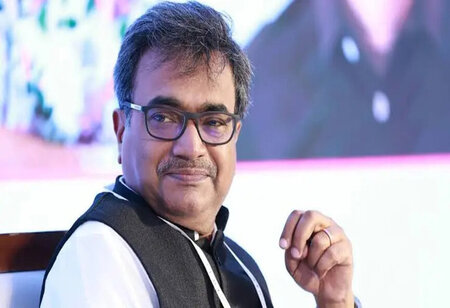Media Literacy for Bureaucrats: A 2025 Guide to Navigating News, Narratives & Negativity
In an exclusive interaction with Media Infotainment, Dr. Navneet Anand, Founder and Director of GreyMatters Communications, delves into the urgent need for media literacy among bureaucrats in the digital age. Drawing from his extensive experience in public affairs, PR, and political consulting, Dr. Anand unpacks his 2025 framework that equips civil servants to decode misinformation, manage narrative control, and maintain public trust without compromising transparency. He outlines actionable strategies for real-time response, narrative resilience, and institutional readiness, reinforcing his belief that informed communication is central to effective governance in a hyperconnected India.
How can public officials differentiate between constructive criticism and orchestrated narrative attacks—especially during policy rollouts or crises?
Citizen consultation and feedback have never been alien to policymaking and it is central to our democratic ethos. Civil servants are normally sensitive to ground realities since they often have a long and varied exposure. They learn the instinct of sifting through the avalanche of criticism that comes their way during training to the service delivery process.
But now in this era of hyperbolic news that is produced and/or digested almost at the speed of light, it may be difficult to tell the difference between real criticism and lies that are scripted by marketing geniuses. One can filter out the wheats and goats by evaluating the tone as well as the seriousness of the message. As an example, a harsh op-ed in a respectable newspaper tends to be founded on argument and evidence and has a good point. Conversely, an interest driven or even emotional decision can make angry responses to a benign X post about say a fuel price rise go through the roof. Although such responses can signal the mood of the people, they usually do not go deep enough to make effective policy review.
More than ever before, during crisis, public officials need a proper communication architecture: it has to enable them to separate the signal and perform amplification and filtering to signal-to-noise ratio. this can be tracking the attitude on the platforms, checking on sources who can be trusted, and comprehending the setting where the feedback is made.
What role does media literacy play in maintaining public trust, and how can bureaucrats strike a balance between transparency and narrative control?
The emergence of digital media and social-site has even transformed the media environment, diluting most of the checks and balances that traditionally existed in conventional journalism. Media literacy is essential, in such a dynamic situation, not only to the general population, but also to the public-officials and their subordinates.
Being able to realize the origin, dissemination, and amplification of information enables the bureaucrats to be either active in interaction and reaction. Officials can now directly communicate with citizens since they have access to various properly digitalized platforms. The latter increases transparency and, at the same time, provided them with an opportunity to respond to any misinformation in real-time.
It is no longer something to do, rather it is something that must be done and taught to ensure teams know how to read media critically and how to spot a credible source and read it as an opinion or fact. This is not an intention to control the story in a form of manipulation, but to be sure that the people are accessing correct, timely, and contextual information.
With the rise of social media echo chambers and influencer-driven discourse, how should bureaucrats proactively manage misinformation without appearing defensive or partisan?
As the digital platforms proliferate and micro-communities controlled by content creators gain power, more choices than ever before are available to bureaucrats to put their own version of affairs in the public sphere. But the process of dealing with misinformation and being defensive without being defensive needs a bit of finesse.
The bureaucrats will have to acquaint themselves with the social media idioms and mechanism. They ought to learn how to frame messages that are concise, factual, crystal. Time is important and so is the platform. It is desirable to have a message that needs to be spread in rural areas, like a message about a farmer relief package, and hence it must be in the local slang and contain the news about that relief package should be shared on media such as Facebook. In the case of youth-focused campaigns, such as Instagram or even YouTube Shorts, will be a more effective tool.
It can also be assisted by the use of region-based social media influencers. They do not only provide a voice of credibility to the message, but also pushing it to niche communities.
This is a blast-furnace atmosphere. News spreads very fast and sometimes with the help of misinformation. Hence, control needs to be formed in bureaucrats so that they should be able to respond quickly, consistently, and with context, take a tone that is neutral and oriented towards the value of serving the population.
What frameworks or digital tools can bureaucrats in 2025 use to train their teams in media discernment and narrative resilience, particularly in high-stakes decision-making environments?
In the current context there should be a 24x7 response state to bouquets and brickbats. Bureaucrats should not only know how to use the social media platforms as it is but they should also make sure that their teams are well trained to handle digital communication.
That involves establishing media and social media cells, training a small number of officers on digital communications and taking advantage of AI-powered sentiment analysis tools to track the reactions of the population. Their response can be made more agile with crisis communicative drills, scenario planning, and pre-approved templates of high pressurized situations.
This ecosystem is also negotiating with journalists, being responsible in addressing voices of civil society, and having an updated media contact list. After all, readiness is the most optimal model.
Also Read: Creative Advertisement for New Brands: How to Build Buzz on a Budget
What frameworks or protocols should be institutionalized within government departments to ensure responsible consumption and sharing of news among civil servants?
Since Narendra Modi took over as the Prime Minister in 2014,, there has been a marked shift in how the government engages with the media and the public. From the central to state levels, communication frameworks have evolved, with institutions like the Press Information Bureau (PIB) and State Information Departments undergoing significant transformation.
The establishment of the PIB Fact Check Unit is a step in the right direction. Many government departments are now active on social media, and bureaucrats are increasingly open to digesting information from diverse sources, a far cry from the earlier ‘file and folder’ era.
That said, this framework needs to be formalized further. Departments should institutionalize regular training sessions on media handling and narrative management. Officers with aptitude in communication must be identified and assigned media-related responsibilities. Sharing best practices, setting up intra-government resource pools, and inviting experts for workshops will only strengthen this ecosystem. The goal is to ensure that civil servants are not just passive consumers of information but critical and responsible interpreters.
🍪 Do you like Cookies?
We use cookies to ensure you get the best experience on our website. Read more...






